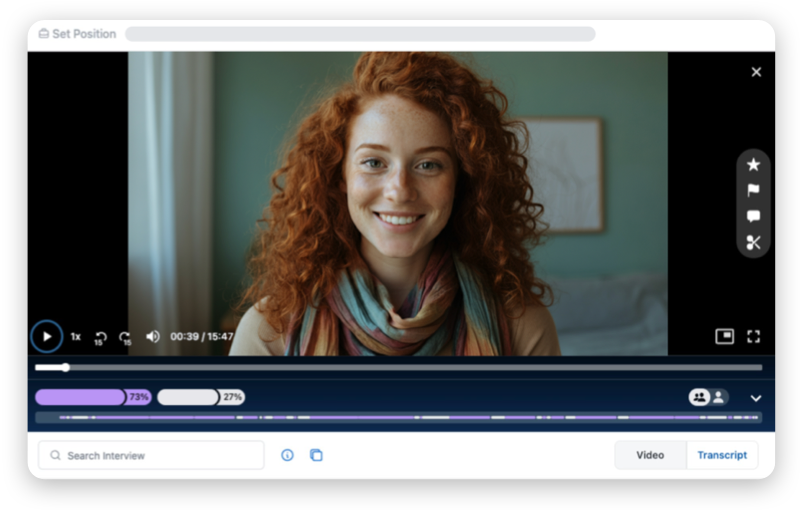HR Compliance & OperationLegal & Regulatory
Find Your Footing in the Shifting AI Regulatory Landscape
Key Talking Points in This Article:
- Learn how to identify high-risk AI systems
- Explore how recent AI Legislation may be impacting your HR team today
- Familiarize yourself with prominent challenges AI poses to the HR industry
- Gain valuable insights into ways your team can thrive in a fast-paced, shifting HR environment caused by the artificial intelligence revolution
Organizations everywhere depend on artificial intelligence to simplify tasks, make better decisions, and uncover new ways to manage business challenges. In human resources (HR), these advancements offer significant benefits. The growing use of AI allows HR teams to handle large applicant pools, conduct performance reviews more efficiently, and detect trends that guide better workforce plans. At the same time, the AI regulatory landscape is expanding rapidly, and leaders must be prepared for new rules on fairness, data handling, and accountability.
Experts in the HR space have emphasized the need for business leaders to place greater importance on how AI may impact their organizational reputation or the rights of employees. When high-risk hiring systems or analytics tools cause unfair outcomes, companies risk lawsuits, loss of public trust, and penalties under the regulation of AI.
Evolving Role of AI in HR and the Need for Regulation
For years, HR teams handled large stacks of resumes, complex scheduling, and fragmented data. The use of AI promises relief by filtering resumes, highlighting top talent, and spotting potential turnover risks. At a broader level, artificial intelligence (AI) can help organizations become more agile, by efficiently matching people with particular skillsets to positions where those talents would be best suited. Artificial intelligence may also be able to optimize training as it can more accurately provide suggestions to employees for personalized training that would benefit them.
Yet these advantages also create challenges.
“Certain AI systems rely on biased or incomplete data, which can heighten algorithmic discrimination or mismanage private information. Even when well-intentioned HR staff introduce AI solutions, they might unknowingly favor one demographic over another.”
Lawmakers in several countries are now working on crafting guidelines to better regulate AI and it’s uses, as a proactive measure to protect workers from biased or unfair work conditions. In Europe policymakers regularly push for a consistent regulatory framework, while American lawmakers are attempting to weigh-up the promotion of innovation with fairness for employees in their regulatory considerations.
An organization might face demands from both a state and local level measure and a federal approach, not to mention regional laws abroad. Recently, Colorado has started to place stricter regulations on the use of AI, through their Artificial Intelligence Act, which could impose yearly evaluations of certain HR algorithms, while the Federal Trade Commission (FTC)currently has the power to review potentially deceptive use of AI tools.
The growing body of legislation directly influencing AI usage in several countries calls for business leaders to begin implementing more comprehensive plans for AI oversight in order to ensure compliance with the ever-shifting legal landscape.
Classifying and Managing High-Risk AI
Identifying High-Risk AI Systems
High-risk AI systems are those that have a significant impact on careers or overall well-being. As an example, consider an automated tool that eliminates half the resumes before human review. This could dramatically influence many prospective candidates’ job prospects.
“A predictive platform that tries to identify future leaders based on limited data could inadvertently favor one background over another. These cases often violate the spirit of regulation of AI if they harm applicants’ opportunities.”
Another key part of a risk-based approach is seeing whether these AI systems rely on incomplete data that may exclude certain demographics. An HR oversight team may discover that an algorithm only accounts for alumni from only a narrow set of schools, creating an inherent bias. In response, teams can adjust the training set, gather additional data, or make it clear that final decisions will be reviewed by a person. This process of early identification and intervention helps keep high-risk tools from undermining fairness.
How to identify high-risk systems:
- Determine the scope of impact: Check if the AI tool directly affects hiring decisions, promotions, or pay.
- Assess data sources: Review whether the system relies on a narrow dataset or excludes certain demographics.
- Examine past biases: Investigate historical hiring records or performance reviews to see if they reflect unfair patterns.
- Implement human review: Provide opportunities for managers to override or question the algorithm’s recommendations.
Algorithmic Discrimination and Related Risks
Algorithmic discrimination takes place when an automated decision system favors or rejects certain groups based on skewed data or design flaws. For example, if a historic hiring record emphasizes only certain universities, a newly deployed platform might follow suit.
Even if AI developers had no intention to discriminate, the consequences can be the same. Discriminatory challenges may arise with automated decision-making systems that rank candidates for promotions or pay raises when inherent biases are present in company records. Automated decision-making technology (also known as automated decision-making tools) used to assess job applicants, can further deepen these existing biases.
In many cases, HR teams run trial scenarios to check whether these systems unfairly penalize protected groups. If problems surface, the company might adjust the training data, modify weighting factors, or enforce a final human check. These steps reduce legal risks and create a fair environment for employees and applicants.
AI Regulatory Reform Impacting the Field of HR
The European Union’s AI Act
One of the broadest examples of AI legislation is the European Union’s AI Act, commonly referred to as the EU AI Act. It groups AI systems into categories by potential harm, with special controls for high-risk AI systems. HR functions, like automated applicant screening, often fall under those higher-risk labels.
Essential parts of the AI Act include examining how accurately AI models perform, confirming they do not introduce harmful biases, and using a risk-based approach to determine when extra checks are needed. For example, a resume-scanning tool should explain which factors it considers in ranking candidates.
“Companies doing business in the EU must also ensure their training data is broad enough to avoid bias against certain genders or ethnic groups.”
By promoting trustworthy AI, the AI Act encourages openness about how machines impact people’s careers. To comply, many HR teams have set up internal rules or established an AI board. They also re-examine AI models if results appear skewed. Failing to meet these guidelines can lead to fines or legal battles, so any employer in the EU should carefully consider how to conform to this comprehensive piece of legislation.
Federal Legislation in the United States
Currently, the U.S. lacks a single, comprehensive federal legislation on AI regulation in HR. However, some lawmakers have proposed a sweeping AI bill aimed at standardizing guidelines across the country. Federal agencies such as the federal trade commission already investigate AI-related misconduct, especially if it points to unfair practices or algorithmic discrimination. Yet many HR leaders want clearer national standards to replace the inconsistent measures seen in different states.
A future AI bill could set requirements for employee notifications, data protection, and consistent monitoring of high-risk AI platforms. It might also regulate industries like healthcare or critical infrastructure, where an AI act might mandate extra audits. While no final policy is in place, many organizations are proactively revising their HR processes to demonstrate fairness if the federal government eventually adopts robust rules.
State-Level Measures
At the state and local level, the Colorado AI Act exemplifies AI legislation designed to address high-risk AI systems in hiring or promotion. This law demands annual assessments to detect algorithmic discrimination, obligating employers to inform individuals if AI systems affect employment results. Companies that operate in Colorado must be ready to show compliance, including how their AI applications handle personal information.
Additional states may soon adopt similar regulations. Oversights like failing to meet local standards or ignoring guidance from the California Privacy Protection Agency can erode credibility if workers believe they are treated unfairly. Moreover, certain provisions within the California Consumer Privacy Act specifically address data privacy, reminding businesses to handle sensitive employee information responsibly. By following each local law, organizations reduce the chance of lawsuits and protect their brand image.
Strategic Guidance for AI Governance
Responsible AI Innovation and Oversight
Modern HR departments are increasingly focused on AI governance that encourages just outcomes. This means implementing procedures so AI systems benefit the company without discriminating. A dedicated AI board or working group often reviews new tools, asking about the AI technology behind them, the data used, and whether managers understand the model’s limits.
If red flags appear—like unexplained bias or questionable predictions—leaders can pause deployment until the concerns are addressed.
“Commitment from executives is crucial here: a culture that prizes fairness can empower HR teams to conduct deeper audits. Linking AI development goals with the company’s broader mission can unify staff behind ethical usage and reduce negative impacts.”
Data Practices and Transparency
Data quality is vital for every AI system, so flawed or incomplete data can yield unfair results. Many businesses define risk management policies that outline who can access or transform data, and they keep logs to confirm routine inspections. This helps reduce repeated or erroneous references to personal details that might spur algorithmic discrimination.
In addition, transparency is a key factor. Employees should be told if decisions about their pay or performance come from an automated method. By openly explaining the use of AI, companies foster mutual trust: staff realize they’re dealing with a program that may weigh specific metrics in ways humans might not. Such communication reflects the idea that workers have a right to understand how decisions affecting them are formed.
Organizations may need to consider the following ways to improve their data practices and transparency in the future:
- Establish clear data protocols: Define who has permission to collect and edit HR data, and create logs to track these changes.
- Conduct routine accuracy checks: Schedule regular inspections to confirm data is up to date and free of errors.
- Disclose AI involvement: Inform employees when automated methods are used to evaluate performance or set pay levels.
- Offer ways to appeal: Ensure workers have a channel to challenge or clarify decisions made by AI-driven tools.
Transparency in Generative AI
Generative AI represents a newer wave of automation, crafting text, images, or videos that can streamline HR work. An HR manager might employ generative AI for drafting job ads or preparing onboarding modules. Yet these automatically generated materials sometimes misrepresent the role or incorporate hidden bias if the underlying data is skewed.
To mitigate problems, many firms require a human editor to review the final output before wide distribution. They remain on guard for inadvertently biased or misleading language. Some AI-generated documents could overpromise working conditions or omit challenging aspects of a job.
“As privacy rules expand, there may also be mandates to label certain AI-generated content, so leaders should remain ready to prove how such text was created.”
Emerging tools such as facial recognition add another layer of complexity. While they can improve security or verify identities, they also raise concerns about privacy and potential bias, urging employers to confirm that these systems meet ethical standards and do not unfairly harm particular groups.
Industry Collaboration and Future Outlook
Partnerships and Inter-Organizational Initiatives
The global nature of AI worldwide means it can be tough for individual businesses to keep up. Many partner with AI developers, universities, or associations, pooling knowledge to overcome issues like algorithmic discrimination or data privacy. These collaborations often result in more reliable AI solutions customized to HR demands.
Some enterprises also join forces with a government agency or leading groups to shape proposed legislation. Participating in these dialogues allows companies to share real-world insights and promote workable rules. External AI research can also accelerate best practices that help the entire industry. As these technologies advance, cooperative strategies for fairness and accountability will probably become standard.
General Purpose Models and Standardization
A number of AI models in HR use broad, general-purpose AI models that can be adapted for screening resumes or gauging employee sentiment. Techniques like natural language processing and machine learning raise questions about reliability and impartiality. Organizations such as the National Institute of Standards and Technology (NIST) aim to guide employers in choosing high-quality AI systems.
By establishing consistent standards, HR managers more easily detect potential issues. If a model meets recognized criteria for accuracy and fairness, the use of AI becomes less risky. Common benchmarks also help smaller organizations lacking big data teams. They can be confident that vendors meeting the guidelines uphold essential ethics.
Keeping Pace with Future Regulations
As the AI regulatory landscape expands, businesses need flexible strategies to keep up with new rules. Many experts predict that nation wide legislation may soon unify or simplify patchwork policies, while local rules evolve to demand regular audits or public disclosures. Compliance in the future will entail progressively more reviews of AI systems and training for HR specialists who implement them.
Some organizations create AI offices to monitor shifting requirements and coordinate responses. These teams focus on tracking changes to current artificial intelligence legislation, or demands from the federal government. By anticipating shifts, companies can adapt calmly rather than scrambling at the last moment.
Balancing Fairness, Compliance, and Innovation
Today’s AI regulatory landscape is no longer an optional consideration for businesses using advanced technology in HR.
“Regulators from a growing number of countries now expect more transparency and fairness in high-risk processes such as hiring and promotions.”
To succeed in this environment, HR teams should identify high-risk AI systems early and adopt a risk-based approach to algorithm validation. They can also reduce algorithmic discrimination by applying risk management policies and verifying that data covers a diverse population.
Well-managed artificial intelligence AI can help organizations stand out, especially as AI companies bring new innovations to market. By combining ethical principles, thorough audits, and cautious AI-generated content review, businesses can harness AI solutions that benefit both the company and its workforce. The result is a forward-looking approach that balances efficiency, compliance, and respect for the human dimension of work.










